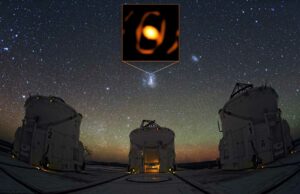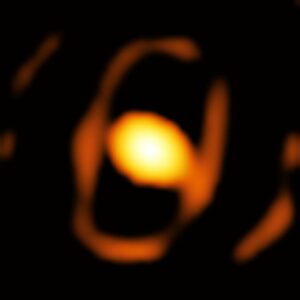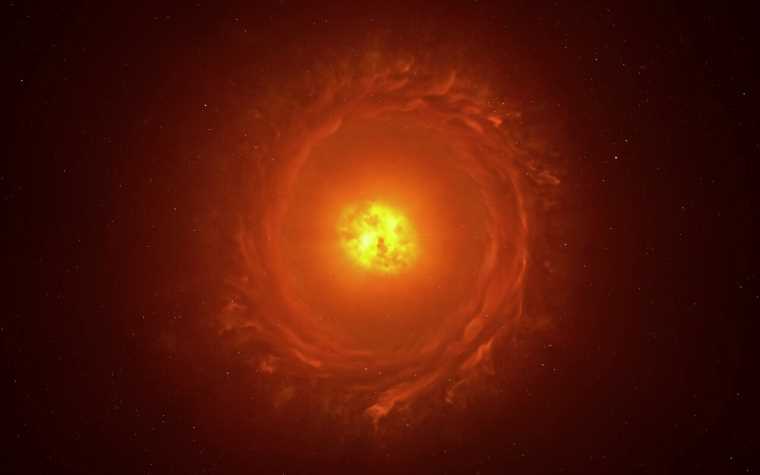Astrophysicist Keiichi Ohnaka from the Universidad Andrés Bello in Chile has successfully captured the first-ever close-up image of a star in another galaxy thanks to the power of the European Southern Observatory’s Very Large Telescope Interferometer (ESO’s VLTI).
Dubbed WOH G64, the star is over 160,000 light-years from Earth within the Large Magellanic Cloud, making it the furthest stellar object to be imaged in this detail. According to estimates recently cited by the European Southern Observatory, it is also at least 2,000 times the size of the Sun, earning it the nickname the “behemoth star,” and may be in the final stages of life before going supernova.
“For the first time, we have succeeded in taking a zoomed-in image of a dying star in a galaxy outside our own Milky Way,” said Ohnaka. The astrophysicist also noted that his team found an “egg-shaped cocoon closely surrounding the star,” supporting the idea it was preparing to explode.
“We are excited because this may be related to the drastic ejection of material from the dying star before a supernova explosion,” Ohnaka explained.


GRAVITY Enables First-Ever Image of a Star in Another Galaxy
According to a statement announcing the unprecedented discovery, Ohnaka and his team have been studying WHO G64 since 2005. These efforts have revealed numerous details about the behemoth star, but attempts to capture a close-up image have “remained elusive.” In fact, the team says they had to wait until 2015 for the observatory to complete the development and installation of the facility’s second generation of instruments, GRAVITY.
“GRAVITY is born from the desire to observe very small details of faint objects, including those at the centre of galaxies,” explains Xavier Haubois, ESO astronomer at the VLTI, on the instrument’s home page. “With its high sensitivity and accuracy, GRAVITY can reveal a whole new world of planets, stars, and galactic centres that were previously out of reach because they were too faint for previous instruments.”
With GRAVITY installed and operational, Ohnaka and his team again pointed the ESO’s instrument at their behemoth star and waited for the results. Unlike previous attempts, GRAVITY’s “huge step forward in sensitivity and accuracy” gathered enough light from several telescopes to create the first-ever close-up image of a star in another galaxy.
When comparing the new readings from GRAVITY to those taken during previous observations, the team also found that the behemoth star was undergoing significant changes. Specifically, it appeared to be dimming considerably over a relatively short period, a telltale sign that a star is nearing the end of its life.


“We have found that the star has been experiencing a significant change in the last 10 years, providing us with a rare opportunity to witness a star’s life in real-time,” explained Gerd Weigelt, an astronomy professor at the Max Planck Institute for Radio Astronomy in Bonn, Germany and a co-author of the study.
The team says the dust cloud surrounding the star is the likeliest cause of this dimming. The team also said that the egg-shaped cloud was unexpected and didn’t fit predictions made by software models or previous observations. They suspect this unexpected shape could be caused by a yet-to-be-discovered companion star but is more likely caused by the star shedding gas.
Although a star shedding its outer layers of gas may indicate it is preparing to die, the researchers caution that its ultimate death may still be thousands of years away. Still, according to one of the study’s co-authors who has been watching the behemoth star since the 1990s, Jacco van Loon, the Keele Observatory Director at Keele University, UK, its extreme size and state means any significant alteration in its dynamics could trigger a demise at almost any time.
“This star is one of the most extreme of its kind, and any drastic change may bring it closer to an explosive end,” he explained.
Future Observation with GRAVITY+
After capturing the historic image, Ohnaka says that performing additional observations of WHO G64 will be critical for understanding “what is going on in the star.” He also concedes that its ongoing dimming makes this particular star in another galaxy harder to see, even for GRAVITY. Fortunately, the facility says it plans to upgrade its interferometer even further. They are calling that effort GRAVITY+.
According to the ESO’s project page, the GRAVITY+ upgrades will include state-of-the-art adaptive optics technology designed to “enable better correction of the blur caused by the Earth’s atmosphere.” This same technology will improve the contrast of observations, resulting in clearer images of brighter objects. The ongoing upgrades will also improve the instrument’s “fringe tracking capability,” resulting in the ability to capture objects in the cosmos “in unprecedented detail.”
“The upgrade will enable the discovery and characterisation of exoplanets, the imaging of young stars and their protoplanetary disks, and the search for intermediate-mass black holes,” the GRAVITY+ project site explains. “It will also take us deeper and closer to Sagittarius A*, the black hole at the centre of the Milky Way, providing us with a better understanding of our galactic centre.”
The study “Imaging the innermost circumstellar environment of the red supergiant WOH G64 in the Large Magellanic Cloud” was published in Astronomy and Astrophysics.
Christopher Plain is a Science Fiction and Fantasy novelist and Head Science Writer at The Debrief. Follow and connect with him on X, learn about his books at plainfiction.com, or email him directly at christopher@thedebrief.org.

